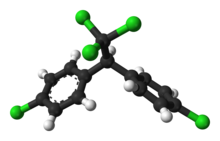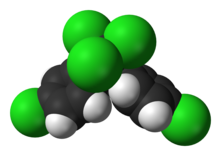ඩී.ඩී.ටී

| |

| |

| |
| Names | |
|---|---|
| IUPAC name
1,1,1-trichloro-2,2-di(4-chlorophenyl)ethane
| |
| Identifiers | |
| CAS number | (({value))} |
3D model (JSmol)
|
|
| ChEBI | CHEBI:(({value))} |
| ChemSpider | |
| DrugBank | |
| ECHA InfoCard | 100.000.023 |
| KEGG | (({value))} |
| PubChem | (({value))} |
| RTECS number | (({value))} |
| UNII | |
CompTox Dashboard (EPA)
|
|
| InChI | |
| SMILES | |
| Properties | |
| Molecular formula | C14H9Cl5 |
| අණුක ස්කන්ධය | 354.49 g/mol |
| Density | 0.99 g/cm³[1] |
| Melting point |
109 °C[1] |
| Boiling point |
decomp.[1] |
| Hazards | |
| Occupational safety and health (OHS/OSH): | |
Main hazards
|
T, N |
| Lethal dose or concentration (LD, LC): | |
LD50 (median dose)
|
113 mg/kg (rat) |
Except where otherwise noted, data are given for materials in their standard state (at 25 °C [77 °F], 100 kPa).
| |
ඩී. ඩී. ටී. (එහි සාමාන්ය නාමය ඩයික්ලෝරෝ ඩයිෆීනයිල් ට්රයික්ලෝරෝඑතේන් ය.) යනු කෘත්රීම පලිබෝධනාශයකි.
එය ආවේනික හා මතභේදයට තුඩු දෙන දීර්ඝ ඉතිහාසයකින් යුත් රසායනික ද්රව්යයකි .
1874 ප්රථම වරට සංස්ලේෂණය කරන ලද DDT වල කෘමිනාශක ගුණය 1939 තෙක් සොයා ගෙන නොතිබුණි. දෙවන ලෝක යුද්ධයේ මුල් කාලයේ දී DDT, හමුදා හා සිවිල් ජනගහනය අතර මැලේරියා, ටයිපස් උණ ව්යාප්ත කරන මදුරුවන් හා අනෙකුත් කෘමීන් නිසා ඇතිවන ලෙඩරෝග පාලනය කිරීම සඳහා විශාල වශයෙන් යොදා ගැනුණි. ස්විට්සර්ලන්ත ජාතික රසායනඥයෙකු වූ පෝල් හර්මන් මූලර්ට 1948 දී " සන්ධිපාදකයන් කිහිපයකට එරෙහිව ස්පර්ශ විෂ ප්රභේදයක් ලෙස DDT හි අතිශය කාර්යක්ෂම බව සොයා ගැනීම" වෙනුවෙන් කායික විද්යාව හෝ වෛද්ය විද්යාව පිලිබඳ නොබෙල් සම්මානය පිරිනැමුණි. යුද්ධයෙන් පසුව DDT කෘෂිකාර්මික කෘෂිනාශක ලෙස යොදා ගැනීම ආරම්භ කළ අතර ඉතා ඉක්මනින් එහි නිෂ්පාදනය හා භාවිතය ඉහල යන ලදී.
1962 දී ඇමරිකානු ජීව විද්යාඥයෙකු වූ රැචෙල් කාසන්ගේ "Silent Spring" නැමැති ග්රන්ථය ප්රකාශයට පත් කරන ලදී. එම ග්රන්ථය මඟින් අඛණ්ඩව DDT භාවිතය මඟින් එක්සත් ජනපදයේ ඇති වන පාරිසරික බලපෑම් සාකච්ඡාවට බඳුන් කළ අතර එමඟින් පරිසර විද්යාවට හෝ මානව සෞඛ්යයයට ඒවායේ බලපෑම සම්පූර්ණයෙන්ම තේරුම් නොගෙන රසායන ද්රව්ය විශාල ප්රමාණයක් පරිසරයට නිකුත් කිරීමේ තර්කනය ගැටළුවට බඳුන් කරන ලදී. එම ග්රන්ථය මඟින් DDT හා අනෙකුත් පලිබෝධනාශක මඟින් පිළිකා ඇති කළ හැකි බව දැක්වූ අතර ඒවායේ කෘෂිකාර්මික භාවිතය වන ජීවිතයට (විශේෂයෙන් කුරුල්ලන්ට) හානි කර බව ද දැක්වීය. එහි ප්රකාශනය පාරිසරික ව්යාපාර ඇති වීමේ සන්ධිස්ථානයක් විය. Silent Spring ග්රන්ථය නිසා විශාල මහජන හඬක් ගොඩ නැඟුනු අතර එමඟින් 1972 දී DDT භාවිත බොහොමයක් ඇමරිකාවෙන් ඉවත් වන ලදී. ඉන්පසුව DDT ලොව පුරාම කෘෂිකාර්මික භාවිතවලින් ඉවත් වූ නමුත් එහි රෝගාබාධ පාලනයේ සීමා සහිත භාවිතය වර්තමානය දක්වාම ලෝකයේ සමහර කොටස්වල භාවිතා කරන අදටත් මතභේදයට තුඩු දුන් කරුණක්ව තිබේ.
උපද්රවයට පත්වූ සත්ව විශේෂ පිළිබඳ නීති පනතත් සමඟ DDT සඳහා වූ ඇමරිකානු තහනම විද්යාඥයින් විසින් දකින ලද්දේ ආසන්න ඇමරිකාවේ bald eagle හි නැවත පැමිණීමේ ප්රධාන සාධකයක් ලෙසය.
මුලින්ම සංස්ලේෂණය කරන ලද්දේ 1874දී ය. ඩී.ඩී.ටී. වල කෘමිනාශක ගුණය 1939 වන තුරුම අනාවරණය කරගෙන නොතිබුණි.
Text is available under the CC BY-SA 4.0 license; additional terms may apply.
Images, videos and audio are available under their respective licenses.
